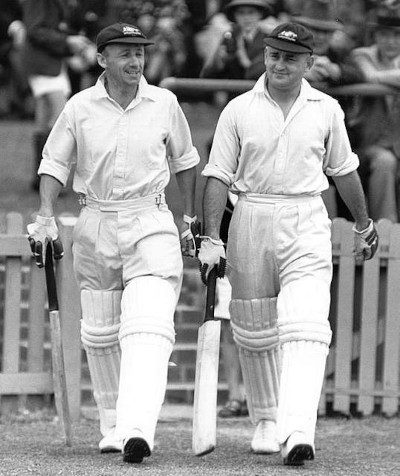Table of Contents
Ashes contests between England and Australia have often been fiery affairs but nothing has come close to the 1932/33 series down under. Hostile, intimidatory bowling from the English attack led to some serious ill feeling which is still discussed over 85 years later.
What is Bodyline Bowling?
Bodyline is also known as leg theory and that gives a clue as to what it’s about. The intention is for a right arm bowler to deliver around the wicket into the batsman’s body. The ball is short pitched and the aim is to intimidate the batter and to get them to fend off the delivery towards fielders on the leg side.
To get the idea, check the video below.
The Evolution of Bodyline Bowling
Many may think that bodyline was born in that 1932/33 series but the practise has been around for a lot longer. By the start of the 20th century, a number of bowlers were beginning to use leg theory as a legitimate tactic.
The deliveries weren’t necessarily short but the bowler would often direct the ball at, or outside of leg stump. This made it difficult for the batsman to play a shot anywhere but on the leg side. That leg side would be packed with fielders and the aim for the bowling team was for the batters to hit the ball in their direction.
The next big development in the history of bodyline bowling came in the 1920s. It was at this point that leg theory started to involve shorter balls that were directed at the batsman’s body. It’s said that bodyline became prevalent in Australia and that captains were split as to whether the tactic should be used.
This progress exploded in 1932/33 when bodyline was used extensively during England’s Ashes tour. Under the guidance of controversial captain Douglas Jardine, fast bowlers Harold Larwood and Bill Voce were the main exponents of short pitched leg theory.
Bowling to a packed leg side field, the England side of that season won the Ashes but left behind plenty of ill feeling with battered and bruised Australian batsmen brushed aside.
The Spirit of Cricket
Even in the 19th century, the concept of leg theory was considered to be ungentlemanly and against the spirit of the game. By the time that the bodyline series came along in 1932, most people inside cricket felt that the English bowlers had definitely crossed a line.
Don Bradman
With a test batting average just below a perfect 100, most people in the game feel that Sir Don Bradman was the greatest batsman that cricket has ever seen. In the 1930s, the Australian was at the height of his powers and opposition teams were looking at new ways in which to combat his brilliance.
In the previous series between England and Australia in 1930, Bradman had scored 974 runs in five tests at an average above 139 and that’s a record that stands to this day. Clearly his was a key wicket and, as part of their plans to dismiss Bradman in 1932/33, England brought in their bodyline tactic.

England’s Bowling Tactic in the 1930s
England’s touring party of 1930 used a more sustained and hostile form of leg theory than had previously been seen. When the tactic was used, there was no real intention to bowl at the stumps. The bowlers would pitch short with a view to getting the batsman to fend a catch into the packed leg side field or, the batter would be hit and therefore intimidated.
The practise was used in two warm up matches and there was some success. Crucially, Don Bradman played in those games and failed to impress in either of them. The tourists had the green light to continue with bodyline and it was to have a devastating effect in the test matches that followed.
While controversy had been simmering in the first two games, it exploded in the third test. This was the game where Australia’s Bill Woodfull was struck a sickening blow in the chest while Bertie Oldfield suffered a fractured skull. The unpleasant side of bodyline was now clear for all to see.
Ultimately, it could certainly be argued that bodyline was successful in the sense that England won the series by four tests to one. The Australian Cricket Board stated that they considered the tourists to have bowled fairly but not everyone was in agreement.
Australia’s cricket watching public were appalled by the tactics and Englishmen were also unhappy. The concern even spread to the English tour manager, Sir Pelham Warner. It was largely because of this split opinion that the 1930s form of bodyline was never seen again but that was also due to a change in the game’s laws.
Controversy Over Bodyline Bowling
There are a number of reasons why bodyline in 1932 and hostile leg theory in the modern day are considered to be controversial. Firstly, there is that question of the spirit of the game: The task of the bowler is to dismiss the batsman using all of their skills, including seam and swing.
For many, the first aim of bodyline bowling is not to dismiss the batsman but to intimidate them. Back in that 1932/33 Ashes series, there were plenty of dismissals secured by Larwood and Voce but Australian batsmen also suffered injury on occasions and had to retire.
Then there is the question of hostile bowling in general. Don Bradman was the best batsman of his, and possibly any era, but bodyline was used indiscriminately in 1932/33. All batters were targets as far as the England attack were concerned.
The question of intimidation is still discussed in the modern day. Until relatively recently, it was common for bowlers not to deliver fast bouncers at tail enders but that doesn’t seem to be the case today. Those short balls may not involve a leg theory line but the spectre of bodyline still remains in this type of discussion.
In the main, it’s all about playing fair and upholding the spirit of the game: Ever heard the expression, It’s Just not Cricket?
Modern Examples of Bodyline Bowling
There are isolated occasions where leg theory is specifically used and we saw an example of this as recently as 2021. In the test series between India and Australia, the Australian bowlers were having a tough time dismissing the obdurate batsman Cheteshwar Pujara.
A patient accumulator of runs, Pujara had faced more deliveries than any other batter in the series and pace bowler Pat Cummins decided to do something about it. From a ‘round the wicket’ angle, Cummins started to bowl short and into Pujara’s body with the result that the batsman was hit on no fewer than nine occasions over the course of a single day.
Other bowlers got in on the act but Cummins was the main aggressor, hitting Pujara no fewer than six times.
Leg theory can be used as a negative tactic and it’s not necessarily exclusive to fast bowlers. I can remember England being frustrated so much by the great Sachin Tendulkar that left arm slow bowler Ashley Giles bowled outside of his leg stump.
Ultimately, the tactics worked as Tendulkar was stumped for the first time in his career as the frustration got the better of him. It’s happened on other occasions with less success and I can confidently say that it makes for some very dull cricket.
This isn’t bodyline in the strictest sense as a change to the laws stops teams replicating England’s tactics of 1932/33 but it can certainly be classified as ‘leg theory’.
Consequences of Bodyline Bowling
There was considerable ill feeling between England and Australia in the wake of the 1932/33 Ashes and the series had a direct impact on the careers of certain individuals. In the second test, the Nawab of Pataudi made a century for England but he never played again after refusing to move to a leg side fielding position.
Skipper Jardine is said to have stated that ‘his highness is a conscientious objector’. Harold Larwood was asked to write an apology letter and he refused, meaning that he never played test cricket again after 1933.
As for Douglas Jardine, his final test came a year later in 1934 but it’s fair to say that his reputation wasn’t exactly enhanced.
Changes to the Laws of Cricket
Shortly after that Ashes series, a ruling was put in place stating that no more than two fielders could be placed behind square on the leg side, and that was a key tactic for Douglas Jardine’s men.
Later on, additional laws restricted the number of bouncers that a bowler could send down during an over. While this isn’t directly related to bodyline, there is a connection to that 1932/33 series and the ongoing question of intimidatory bowling.
The MCC also stated that Bodyline breached the spirit of the game and the English side was widely criticised within the sport. In general, while the tactics won England a test series, few people in the game are happy with the way in which the Ashes were regained in 1932/33.
Is Bodyline Bowling Legal?
While cricket laws don’t specifically name bodyline, the practise that was undertaken by England in 1932/33 has effectively been outlawed. We’ve seen the ruling relating to fielders behind square leg and that would make it impossible to replicate the English bowler’s tactics from that Ashes series.
In the present day, as we have seen with the contest between Pat Cummins and Cheteshwar Pujara, bodyline can still be applied but it’s very different from the type of contest seen back in the 1930s.


